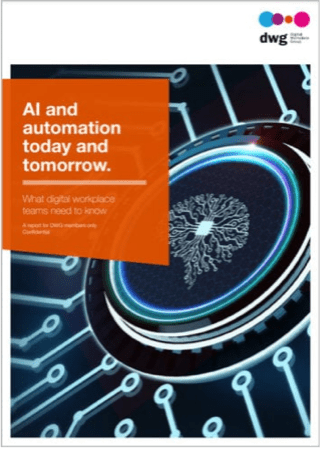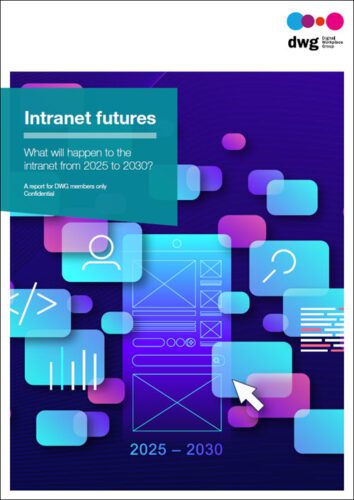AI and automation: 11 considerations for digital workplace teams
By Steve Bynghall
One of the strengths of DWG’s research programme is that each year we seek feedback and carefully consider the topics to cover so that we can be sure to focus on the areas where we can deliver most value. The research list goes through a pretty rigorous process with, at first, a longlist compiled of topics based on various inputs, including questions we receive from members through our AskDWG service as well as suggestions from the network of DWG experts. This then gets narrowed down to a shortlist through more input, with the final list then voted on by DWG members.
Unsurprisingly, ‘AI and Automation’ was one of the topics chosen for our 2020 programme and so earlier this year we published a new member report: AI and automation today and tomorrow: What digital workplace teams need to know. Although the full report is for DWG members only, you can download an excerpt.
I felt this was an important topic to write about, not just because artificial intelligence (AI) and automation are starting to have major impacts on the digital workplace and the tools and channels within it, but also because there are so many misconceptions and misunderstandings associated with AI and automation, around both their outcomes and what is involved in driving value from these still emerging technologies.
At DWG, we’ve long advocated a sensible and balanced approach to AI and automation. Back in 2018, I wrote about the importance of taking a level-headed view – and digital workplace teams can play a role in providing this clarity and guiding stakeholders across the enterprise towards the best uses of AI. The new research report was written with this view in mind, as well as with the aim of providing an overview of the foundations and governance that digital workplace teams can help to establish.
We also take a look at a wide range of use cases where AI and automation can deliver value through:
- process improvement right through to digital transformation
- reduced costs, time and increased productivity at the organizational, team and individual levels
- improved employee and customer experiences
- innovation with new products and services, bringing an accompanying culture of innovation
- better decision-making and helping people to be more effective in their roles
- the reduction of risks and errors
- a wide variety of other specific outcomes and benefits.
11 considerations and misconceptions associated with AI and automation
At the beginning of the report we cover a number of key misconceptions, considerations and challenges commonly associated with AI and automation, which can help get them into perspective. Here are some of the things we mention.
1. AI is a technology for the present and future
Artificial intelligence and automation are associated with the future and there’s still a whiff of ‘science fiction’ about these terms. However, to consider them purely as a technology for the years to come is to ignore the impact AI is already having in the present. AI, machine learning (ML) and related concepts are being commonly applied right now in the products and tools you use in your digital workplace. This is why we called the report AI and automation today and tomorrow.
2. The terms come with baggage
AI and automation are associated both with utopian and dystopian outcomes – which can provide an unhelpful distraction from thinking about how to get value from AI and move things forward. Depending on your view, AI and automation will either save or endanger the human race. However, while the future of AI may have some very profound consequences for the way we live, this is not necessarily a relevant consideration in, for example, thinking whether AI can help you auto-tag content to improve findability on your intranet.
3. Vendor noise and contribution
Technology providers can overuse AI-related terminology in marketing collateral and may overstate the impact, leading both to overly high expectations but also to cynicism around the potential impact. However, they are also playing an essential role in enabling AI and automation through their products and services.
4. The term changes over time
What constitutes AI can change over time; a capability that at one point is new will eventually become normalized and then less associated with the AI label. For example, there may be a time when machine translation of text, or even voice recognition, becomes less associated with conversations around AI and automation. At that point, it’s no longer artificial ‘intelligence’ or automating a manual action, it’s just what the technology ‘does’.
5. An umbrella term for different technologies
AI is often characterized as a single, homogenous technology, but actually it is an umbrella term for several emergent technologies. For example, McKinsey Global Institute research breaks AI down into five overlapping areas that include robots and automation, and machine learning. The 2020 Gartner Hype Cycle for AI covers 28 elements, all at differing stages of maturity. Similarly, automation is a general term that can describe the application of numerous different technologies.
6. Humans often do it better
AI is still evolving and is not always effective, with many areas still relying on human judgement. For example, at Facebook, AI supports 15,000 content moderators who remove harmful material – but only by prioritizing the potentially more sensitive content in the moderation queue. In another well-known example, robots were found to be slowing down the production of Tesla cars, resulting in a scaling back of automation to drive efficiency and prompting Elon Musk to declare: “Humans are underrated.”
7. Data dependencies underpin value
One thing that is not always appreciated is that there can be data governance and information management dependencies when introducing advanced automation or higher value AI across different use cases; for example, you may need robust profile data to deliver a solution that leverages AI to make content suggestions for employees. AI makes sense of data so there is always going to be a need for data as an input; but there may be work that you have to do to complete, format and then manage this data to enable AI and automation to work.
8. Nobody owns AI and automation
AI and automation are likely already to be in operation across multiple use cases. It is hard to assign an overall owner for AI and automation as it is a bigger concept than one function or even a cross-functional structure can lay claim to owning outright. This is important in considering how you advance and support AI and automation, both in providing that support and also in driving governance. In many organizations, the current AI and automation landscape may consist of multiple small initiatives across different departments, functions and lines of business, although it is possible that IT may play some kind of due diligence role across all technology-related projects.
9. Governance adds value
Data dependencies, lack of overall ownership, a wide variance in use cases and ethical considerations are just some of the reasons why adding some governance to drive standardization and minimize risks around rolling out AI and automation can have a very positive impact. Digital workplace teams can play a role here in stating the need for governance, designing the framework and then making it happen.
10. There are new skills to learn
Successfully implementing AI and automation requires new skills and expertise across central roles, super-users and, arguably, for all employees. Digital workplace teams may need to know how to train machine learning. Super-users may need to know about the opportunities for citizen development or how to evaluate AI in products they encounter. Everyday users may even need to learn about the opportunities for automating everyday processes. Some of these elements are starting to be included in digital literacy programmes.
11. There are ethical concerns
AI has a number of potential ethical challenges around what it is used for and how it is implemented, covering elements such as data privacy, transparency, impact on jobs and roles, potential use cases, and more. In writing the report, I was surprised to find how important establishing an ethical framework around AI and automation is to ensure there are appropriate guardrails in place.
Related resources
Download the free report excerpt:
Listen to the podcast:
Categorised in: Artificial intelligence and automation, Research reports

